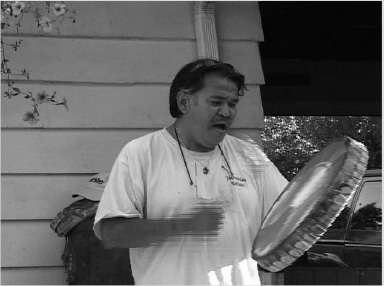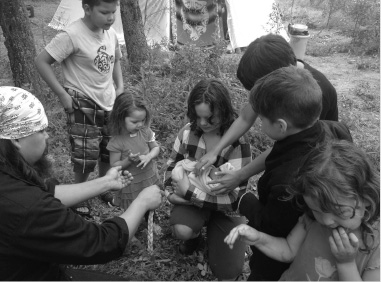

by Nitanis Desjarlais and John Rampanen
The Belly Button Ceremony is a common ritual among many First Nations Peoples. Among the Nuu-chah-nulth, the Belly Button Ceremony is an opportunity to bring together close family members and friends to surround a new life with a loving and supportive environment. Traditionally, immediately following the separation of the umbilical cord from the newborn, the parents host a dinner and invite specific people that they wish to surround their child with. The intention is to announce the child's name and formally introduce them to the community that will assist with their ongoing development within this world. Waiting for the belly button to fall off before family and friends are invited to meet the newborn gives the family the rest and bonding time that is needed in these most precious early days for both mother and baby's healing.
Commonly, up to ten couples are invited to participate. They are fed a meal and are generally gifted with the plates and utensils used during the course of the meal. This token is provided as a way to thank them for the very important role and responsibility that is being passed on to the invitees. Essentially, the role of those invited is to greet the newborn and to be present as role models and guides throughout the child’s life.
During this ceremony, the participants often share lullabies and sentimental songs or words of praise and honor. Gifts are also commonly provided, but it is the parents who give gifts to the invitees. The goal is to build a foundation for the child, to provide discipline and guidance when things become challenging, and to assist in celebrating their successes. This tradition has much history and is fundamental in ensuring a healthy and strong future for each child.
Contemporarily, the Belly Button Ceremony has been revitalized in a variety of ways.
Our family continues this tradition. Family and friends wait patiently to learn what the name and its meaning are for each of our children. With our first daughter, Kalilah Shai-Anne Rain Rampanen, we were not knowledgeable about this practice. Unfortunately, Kalilah’s placenta was not given to us by the hospital staff. However, her belly button was wrapped once it fell off. We gifted her belly button to her paternal grandmother Charlotte, as we were living at a distance from her at the time and we wanted to ensure that there was a strong connection in place. In fact, the connection was so strong that we soon moved closer to her grandmother and had our next child, Qwyatseek.
Qwyatseek means “Wolf” in Nuu-chah-nulth. It is a spiritually powerful name that we intentionally chose to demonstrate the strength that we had foreseen in our son. His full name, Qwyat-seek Kalevi Keyway Rampanen, is an honoring of his Nuu-chah-nulth and Finnish heritages, and of his father’s role as a warrior, respectively. Qwyatseek was our first child to have a small but significant naming ceremony. Dinner was shared and he was passed around to those that attended to grow a connection to everyone that was there. Qwy’s placenta was provided by hospital staff and his father buried it in a place near strong flowing rapids at a river that we had connected with during the summer of his birth. His belly button was wrapped and is held by his father in a medicine bag.
Traditionally, the belly button is wrapped in cedar and buried at the entrance of the house. This is to ensure that when the children grow up and leave the house, they always will eventually return home. When a child is running around and away from home the elders say, “They are looking for their belly button.” Since we do not own our home and move around a lot, we keep their buttons with us instead.
Our next child’s name, Nikosis Mi’claw Soturi Rampanen, is also an honoring of his Cree, Nuu-chah-nulth, and Finnish heritage respectively. Nikosis means “My Son” in Cree. His second name, Mi’claw, means “Rain” in Nuu-chah-nulth and his third name, Soturi, means “Warrior” in Finnish. In its entirety, his name translates to My Son, Rain the Warrior. Like his brother Qwyatseek, Niko’s belly button is in the possession of his father and is stored in a medicine bag that he always keeps close. Nikosis was formally introduced during a family dinner. Nikosis was our first child born at home, so his placenta was immediately wrapped and shortly after was buried at a place called Seitcher Bay. It is an isolated traditional area on the west coast of Vancouver Island where our family has returned to harvest traditional foods and medicines and to gather during times of celebration as well as hardship. We developed our own ceremonial practice with family members present.
Our next son’s name, Tseeqwatin Taivas Omacheo Rampanen, is again an honoring of his family lineages. Tseeqwatin means “Eagle” in Nuu-chah-nulth, Taivas means “Sky” in Finnish, and Omacheo is Cree for “Hunter.” His full name translates to Eagle Sky Hunter. Tseeqwatin’s belly button, like those of his two brothers before him, is held by his father. By the time that Tseeqwatin was born, we had become more aware of the traditional aspects of the Belly Button Ceremony. We invited family and friends to a feast strictly consisting of traditional foods. This was also the time we started our journey toward a healthy Indigenous diet. Tseeqwatin was introduced by name to the attendees and was passed around the circle while people shared songs and stories. After our meal, our guests stood up and spoke to how they would be involved with raising our baby. Tseeqwatin’s placenta was also taken to Seitcher Bay. It was buried underneath an eagle’s nest by his father and older brother Qwyatseek. They created a prayer while they buried the placenta and plan to share the prayer with Tseeqwatin when he is older.
Our next daughter, Chyyah Anne Nishaana Tansja Otahkosin Rampanen, followed our newly formed naming tradition. Chyyah Anne is a play on her grandmother’s name, Charlotte Anne, and has a very sentimental significance to our family. Nishaana means “Dancing Shawl” in Nuu-chah-nulth, Tansja means “Dancer” in Finnish, and Otahkosin means “She Rises from the Water” in Cree. Thus, her full name is Chhyah Anne Shawl Dancer Rising from the Water. The name also reflects the fact that she was born in the water. Once Chyyah’s umbilical cord fell off, it was wrapped and as we were then living at a distance from her maternal grandmother, it was presented to her, as a means of maintaining their connection. Following suit from our previous child, we hosted a Belly Button Ceremony where we invited close family and friends to a traditional feast; gifted them with the plates, serving dishes, and utensils; and shared songs, teachings, and stories. Chyyah’s placenta was placed in the ocean to honor her connection to the water and, more broadly, the ocean.
Our daughter Ha’lidzox Tseeka Laulaja Rampanen also follows our naming tradition. Ha’lidzox means “Earth” in Tsimshian and honors her late grandfather Victor Reece. Tseeka means “Spirit

Nitanis’ father, Victor Reece—renowned. Tsimshian artist and carver—playing at Tseeqwatin’s Belly Button Ceremony. He sings a lullaby in Tsimshian that he learnt from his mother. “My dad passed away in October. My daughter who was just born was given a Tsimshian name to honor him and those roots that I hold." Victor was born at home in 1946, in the family home in northwestern BC on the banks of the Skeena River.
Chant" in Nuu-chah-nulth, and Laulaja means “Singer" in Finnish. Her full name in English translation is Earth Spirit Chant Singer. Ha’li’s belly button was gifted to her grandmother Sharon, who was the second wife to her maternal grandfather Victor. Again, similar to her two older sisters, Ha’li’s belly button acts as a connection to another matriarch of our family. Her Belly Button Ceremony was very thoughtful and invitations were extended specifically to friends and family who are actively involved in efforts to preserve and protect the lands and waters. Along with the traditional meanings of her name, she also carries a compassion for the environment that feeds and nourishes us. During her Belly Button Ceremony, Ha’lidzox was welcomed by a series of beautiful songs and heartfelt stories and hopes for the future. She was gifted with a beautiful bull kelp rattle. Like the ceremonies that preceded hers, the feast consisted solely of Indigenous foods that we harvested ourselves. Ha’lidzox’s placenta was buried with a crabapple tree as it symbolizes medicinal and nourishing qualities. It is also a very strong tree with strong roots.

Kimowanihtow’s most recent Belly Button Ceremony.
Our eighth child’s belly button fell off seven days after his birth. He was born on the Tar Sands Healing Walk. His name is Cree and means “Thunder Spirit Brings on the Rain.”
To celebrate Kimowanihtow’s arrival, we hosted a dinner with Nitanis’ family, including nieces, nephews, uncles, and aunty, and his kookum (grandmother). We gifted the family for witnessing and sharing in the beautiful experience. Afterward, we buried Kimowanihtow’s placenta at Nipsi (the lake where he was born) outside the tipi and shared a prayer with all his siblings as a vow to retain our connection with their Cree ancestral homeland.
The following day, we began our journey back to the west coast. After three days of travel, we arrived in Nuu-chah-nulth Territory and immediately prepared a feast and welcoming with John’s family. Kimowanihtow’s birth story was shared and the family surrounded the baby with love, laughter, and best wishes. Afterward, we finally made our return to Seitcher Bay and connected the baby with our home by placing his belly button in a specially crafted container that will remain on the oceanside in our beautiful home.